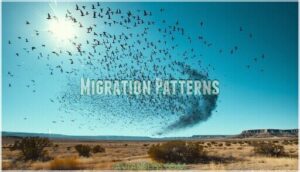This site is supported by our readers. We may earn a commission, at no cost to you, if you purchase through links.
 You’ll encounter 15 remarkable hawks in Texas, each with distinct hunting styles and habitat preferences.
You’ll encounter 15 remarkable hawks in Texas, each with distinct hunting styles and habitat preferences.
The Red-tailed Hawk dominates highways and open fields, while Cooper’s Hawks rule suburban backyards like feathered ninjas.
Sharp-shinned Hawks zip through forests, and Swainson’s Hawks migrate thousands of miles annually.
Texas offers prime real estate for these raptors, from East Texas woodlands to West Texas deserts.
Size matters when identifying them—Cooper’s Hawks are crow-sized, while Ferruginous Hawks stretch nearly three feet.
Their flight patterns tell stories too: soaring, gliding, or that distinctive flap-and-glide rhythm.
Mastering identification requires knowing their secret behavioral tells and preferred hunting grounds, including understanding that size matters and recognizing their distinct hunting styles and habitat preferences.
Table Of Contents
- Key Takeaways
- Texas Hawk Species
- Hawk Identification
- Texas Hawk Habitats
- Rare Texas Hawks
- Hawk Conservation
- Frequently Asked Questions (FAQs)
- How often do you see hawks around neighborhoods in Texas?
- How big are hawks in Texas?
- What is the most common hawk in Texas?
- What does it mean when a hawk hangs around your yard?
- Is it good to have a hawk in your yard?
- What to do if you see a hawk in your yard?
- What attracts hawks to your yard?
- What hawks are protected in Texas?
- Why do I have hawks in my yard?
- What do hawks in Texas eat?
- Conclusion
Key Takeaways
- You’ll find 15 distinct hawk species throughout Texas, from the common Red-tailed Hawk with its signature rusty tail to rare visitors like the massive Ferruginous Hawk and deceptive Zone-tailed Hawk that mimics vultures.
- You can identify Texas hawks by observing their size (ranging from 3-ounce Sharp-shinned Hawks to 4.5-pound Ferruginous Hawks), wing patterns, flight behaviors, and preferred hunting grounds from woodlands to deserts.
- You’ll spot hawks year-round in Texas neighborhoods, especially Red-tailed and Cooper’s Hawks, which are drawn to bird feeders and provide natural pest control by hunting rodents and small mammals.
- You can support hawk conservation by preserving their diverse habitats, reducing collision risks through bird-friendly building designs, and participating in citizen science programs that monitor these protected raptors.
Texas Hawk Species
You’ll find 15 distinct hawk species calling Texas home, from the widespread Red-tailed Hawk with its signature rusty tail to the smaller, bird-hunting Cooper’s Hawk that might visit your backyard feeder.
Texas’s vast landscape, spanning over 268,000 square miles, provides the perfect mix of woodlands, deserts, and plains that support this impressive diversity of raptors year-round and during migration seasons.
Texas’s sweeping landscapes create a raptor paradise where 15 hawk species soar through endless skies.
Red-tailed Hawk
The Red-tailed Hawk (Buteo jamaicensis) reigns as Texas’s most recognizable raptor. You’ll spot these powerful Buteos year-round across the state, from urban parks to rural ranches.
Their distinctive rusty-red tails and piercing screams make hawk identification straightforward for beginners.
Here are five key features to identify Red-tailed Hawks:
- Rusty-red tail feathers that catch sunlight during flight
- Dark belly band across their white chest area
- Broad wings spanning 45-52 inches for soaring
- Variable plumage ranging from light to dark morphs
- Loud, harsh screams echoing "keeeeee-arrr" across territories
These adaptable hunters showcase remarkable hunting techniques, from highway perch-and-pounce tactics to thermal soaring.
Their nesting habits include building stick platforms in tall trees, supporting healthy regional populations throughout Texas.
Red-tailed diet consists primarily of rodents, rabbits, and ground squirrels, making them valuable pest controllers for farmers and ranchers.
Red-shouldered Hawk
You’ll spot this medium-sized raptor’s distinctive checkered wing pattern and reddish-brown breast throughout Eastern Texas habitat.
Their preferred habitat includes wooded areas near water, making their loud "kee-ah" vocalizations during mating rituals from February through June.
Their striking appearance and territorial calls make them one of the easiest Texas hawks to identify during hawk identification efforts.
Swainson’s Hawk
After admiring the Red-shouldered Hawk’s bold colors, you’ll notice Swainson’s Hawk soaring in Texas skies, especially during migration patterns.
Known for dramatic color morphs, these raptors in Texas travel in huge flocks, making them a notable sight.
Their diet variations—grasshoppers to rodents—make them a farmer’s friend, as they help control pest populations.
Swainson’s Hawk breeds in open country, leaving a real agricultural impact among birds of prey in Texas.
Cooper’s Hawk
When you’re backyard birding in Texas, Cooper’s Hawks master urban adaptation like few other raptors in Texas.
These Accipiters excel at bird identification through their distinctive hunting strategies around feeders.
Here’s what makes Coopers Hawk identification easier:
- Size: 14.6-17.7 inches with rounded wings
- Nesting Habits: Build stick platforms in dense tree cover
- Hunting Strategies: Ambush prey with explosive speed bursts
- Urban Adaptation: Thrive in suburban neighborhoods year-round
- Juvenile Identification: Brown streaking versus adult’s blue-gray back
These hawks in Texas demonstrate remarkable nesting habits in residential areas.
Sharp-shinned Hawk
When you spot a sharpshinned hawk at your bird feeder, you’re witnessing one of Texas’s smallest Accipiters in action.
This nimble hunter measures just 9-13 inches, making size comparison with Cooper’s Hawks essential for identification.
Juvenile plumage shows brown streaking, while adults display blue-gray backs.
Their explosive hunting behavior targets songbirds, supporting Texas birdwatching enthusiasts’ observations of expanding hawk species populations statewide.
Hawk Identification
Identifying hawks in Texas requires you to observe key features like size, wing shape, tail patterns, and flight behavior since these raptors can look surprisingly similar from a distance.
You’ll need to note whether the bird has broad, rounded wings like a Red-tailed Hawk or narrow, pointed wings like a Sharp-shinned Hawk, and pay attention to how it hunts and moves through its habitat.
Size and Plumage
Size Dimorphism helps distinguish hawk species in Texas, with females typically 25% larger than males.
Plumage Variation ranges dramatically—from the Red-tailed Hawk’s russet tail to Cooper’s Hawk’s blue-gray back.
Juvenile Plumage often differs substantially from adults, showing streaked breasts instead of barred patterns.
Morph Identification matters for species like Ferruginous Hawks, which display light and dark color phases across Regional Differences.
Behavioral Characteristics
Hawks typically reveal their identity through distinct behavioral patterns you can observe in the field.
Each species displays unique hunting strategies, flight patterns, and social behavior that complement their plumage characteristics.
Watch for these key behavioral clues:
- Hunting techniques – Cooper’s hawks ambush prey while Red-tailed hawks soar and dive
- Flight patterns – Northern harriers fly low with distinctive tilting motions
- Vocalizations – Red-shouldered hawks produce loud "kee-aah" calls during mating rituals
- Social behavior – Harris’s hawks hunt cooperatively in family groups
Some species feature distinctive striped tail feathers that aid identification.
Using Field Guides and Apps
Field guides and birdwatching apps become your identification allies when behavioral clues aren’t enough.
The Audubon Bird Guide offers excellent app accuracy with real-time guide updates, while classic field guides provide reliable offline reference.
Digital vs. print each has merits—apps feature user reviews and sounds, but books work anywhere.
Texas birdwatching resources help overcome identification challenges through thorough hawk identification guides.
Many enthusiasts purchase Texas birding products to enhance their experience.
Texas Hawk Habitats
You’ll find Texas hawks in remarkably diverse habitats, from dense East Texas woodlands where Red-shouldered Hawks nest to arid desert scrublands that support Harris’s Hawks in the south.
The state’s varied landscapes, including coastal marshes, rolling plains, and riparian corridors, create perfect conditions for different species throughout the year, making Texas a haven for diverse habitats.
Woodlands and Deserts
Diverse Texas ecosystems create perfect hunting grounds for both woodland hawks and desert hawks.
You’ll find Red-shouldered Hawks thriving in mixed forest-field boundaries, while Gray Hawks dominate the Lower Rio Grande Valley’s scrublands.
Habitat diversity directly impacts prey availability across these regions.
In South Texas, the Hook-billed Kite’s habitat is a critical factor for its survival.
Key Texas hawk habitats include:
- Mixed forest edges with tall nesting trees
- Desert scrub areas with scattered cacti platforms
- Hill Country woodland zones
- Riparian corridors along river systems
- Second-growth woodlands and orchards
Plains and Marshes
You’ll spot Northern Harriers gliding low over Texas marshes and grasslands, their white rump patches flashing as they hunt.
These prairie hawk species demonstrate unique harrier hunting techniques, tilting side-to-side while searching for prey.
Wetland hawk threats include habitat loss, but Texas ecosystems still support diverse hawk nesting sites.
Watch for their distinctive flight patterns across open plains and wetland edges.
Migration Patterns
Twice yearly, massive hawk migration patterns transform Texas into a raptor superhighway.
Each spring and fall, Texas skies fill with swirling flocks of migrating hawks on their epic journeys.
You’ll witness thousands of Broad-winged Hawks forming spectacular "kettles" along major flyway routes during September.
Seasonal timing triggers these movements, with Swainson’s Hawks creating enormous flock sizes in April.
Northwestern Texas serves as essential stopover habitats, where bird migration patterns concentrate along the Central Flyway’s primary corridor, forming a key part of the Central Flyway.
Rare Texas Hawks
You’ll find four exceptionally uncommon hawks in Texas that require specific conditions and timing to observe successfully.
These rare species—including the massive Ferruginous Hawk, winter-visiting Rough-legged Hawk, vulture-mimicking Zone-tailed Hawk, and water-loving Common Black Hawk—present unique identification challenges that’ll test your birding skills.
Ferruginous Hawk
Among Texas hawks, you’ll encounter North America’s largest buteo during winter months.
The Ferruginous Hawk’s impressive wingspan and rust-colored plumage make identification straightforward in open grasslands.
The short-tailed hawk, Buteo brachyurus, also exhibits distinct color morphs that aid in identification.
Key identification features include:
- Feathered legs extending to talons
- Light and dark morph variations in plumage
- Massive 55-inch wingspan for soaring
- Rust-colored shoulders on light morphs
- Open country hunting strategies targeting prairie dogs
Their conservation status remains concerning due to habitat loss.
Rough-legged Hawk
When winter arrives, you’ll spot Rough-legged Hawks with their Arctic origins showing through distinctive feathered legs extending to their toes.
These hawks in Texas display remarkable plumage variation between light and dark morphs, making identification challenging for Texas birdwatching enthusiasts.
Their hovering hunting strategies distinguish them from other hawk species Texas hosts during colder months.
Zone-tailed Hawk
Zone-tailed Hawks master the art of deception through vulture mimicry, soaring alongside Turkey Vultures during eastern migration through Texas.
You’ll face identification challenges distinguishing these crafty raptors from their larger companions.
Their breeding habits remain poorly understood, contributing to uncertain conservation status.
These hawks in Texas represent one of the most intriguing hawk species Texas birdwatchers encounter during spring passage.
Some hawks have white bellies that provide camouflage against sky backgrounds, which is a key aspect of their vulture mimicry and overall migration patterns.
Common Black Hawk
The Common Black Hawk represents one of Texas’s rarest hawk species, making regional sightings extremely uncommon.
You’ll find this stocky raptor restricted to mature riparian forests near water sources.
Its identification tips include coal-black plumage with distinctive white tail bands.
Diet specifics focus on aquatic prey like fish and frogs.
Conservation status remains precarious due to habitat loss threatening Texas bird species populations.
Hawk Conservation
You can help protect Texas hawks by supporting habitat preservation efforts and reducing collision risks in your own backyard.
Conservation programs across the state focus on maintaining the woodlands, grasslands, and wetlands that these raptors need to hunt, nest, and raise their young successfully, which is crucial for their survival and conservation.
Habitat Loss and Preservation
Texas hawk conservation faces mounting pressure as Land Development transforms vital hawk habitats Texas into subdivisions and shopping centers.
You’re witnessing a critical moment where Nesting Sites disappear faster than hawks can adapt.
Here’s what threatens Texas wildlife:
- Land Development – Urban sprawl eliminates 50,000 acres of hawk habitat annually
- Prey Availability – Reduced rodent populations from pesticide use
- Water Sources – Drought and development limit hunting territories
- Nesting Sites – Tree removal destroys generational roosting areas
- Climate Change – Shifting weather patterns disrupt breeding cycles
Texas bird conservation efforts now protect remaining corridors through strategic partnerships with landowners, safeguarding Texas bird habitats survive for future generations.
Preserving habitats guarantees food security and species survival.
Collision Prevention Measures
Communication towers and power lines create deadly obstacle courses for migrating hawks, but strategic building design and window treatments can dramatically reduce collisions.
You’ll see fewer vehicle strikes when public awareness campaigns educate drivers about hawk migration corridors.
Texas bird conservation laws now require developers to implement bird-friendly structures, while hawk conservation efforts focus on marking dangerous infrastructure to protect these magnificent raptors.
Applying specialized window films can further mitigate collisions, which is a key part of hawk conservation efforts.
Conservation Efforts in Texas
Successful hawk conservation Texas initiatives combine habitat restoration with reducing pesticides across the state.
You’ll find protected areas expanding through partnerships between government agencies and private landowners.
Public awareness campaigns educate communities about Texas bird conservation needs, while citizen science programs engage volunteers in monitoring efforts.
These coordinated bird conservation efforts help secure hawk populations for future generations.
Frequently Asked Questions (FAQs)
How often do you see hawks around neighborhoods in Texas?
You’ll spot hawks in Texas neighborhoods fairly often, especially Red-tailed and Cooper’s Hawks.
They’re drawn to bird feeders, tall trees, and open spaces, making suburban areas prime hunting grounds for these adaptable raptors.
How big are hawks in Texas?
Fifteen hawk species soar across Texas, ranging from tiny 3-ounce Sharp-shinned Hawks to massive 5-pound Ferruginous Hawks.
You’ll spot wingspans from 17 inches to nearly 6 feet wide—quite the aerial size difference!
What is the most common hawk in Texas?
You’ll spot the Red-tailed Hawk most frequently across Texas.
This year-round resident dominates the state’s skies with its distinctive rusty-red tail and piercing scream that’s become the classic "hawk call" in movies.
What does it mean when a hawk hangs around your yard?
Like a feathered landlord, that hawk’s claiming territory around your yard.
It’s found a reliable food source—likely small mammals, birds, or reptiles—and considers your property prime hunting real estate worth defending.
Is it good to have a hawk in your yard?
Having a hawk in your yard brings natural pest control benefits.
They’ll hunt rodents, snakes, and other small animals that damage property.
You’re witnessing nature’s balance firsthand, though they might occasionally target backyard chickens.
What to do if you see a hawk in your yard?
Red-tailed hawks visit 75% of North American backyards annually.
Stay calm and observe from indoors. Don’t approach or feed it.
Remove bird feeders temporarily. The hawk will likely move on naturally within hours.
What attracts hawks to your yard?
You’re likely attracting hawks with bird feeders that draw smaller prey birds.
Open lawn areas perfect for hunting.
Water sources.
Tall perching spots like trees or poles.
And abundant rodent populations around your property.
What hawks are protected in Texas?
Federal law protects every hawk species you’ll encounter.
The Migratory Bird Treaty Act shields all fifteen Texas hawks from harm, harassment, or capture.
You’ll face serious penalties for violating these protective regulations.
Why do I have hawks in my yard?
Like medieval knights patrolling their domain, you’ve got hawks in your yard because it’s prime hunting territory.
They’re drawn to bird feeders, small mammals, and open spaces where prey’s abundant and easy to spot.
What do hawks in Texas eat?
Hawks in your Texas yard hunt diverse prey including small mammals like rodents, rabbits, and squirrels, plus birds, reptiles, amphibians, and insects.
Larger species tackle bigger game while smaller accipiters specialize in backyard birds, making them a notable presence in the ecosystem with their unique hunting specialize.
Conclusion
Mastering the art of spotting hawks in Texas transforms every outdoor adventure into a treasure hunt.
You’ve now got the tools to distinguish a soaring Red-tail from a diving Cooper’s Hawk, and you understand why size, behavior, and habitat matter.
Whether you’re exploring East Texas forests or West Texas plains, these magnificent raptors await your discovery.
Grab your binoculars, practice your identification skills, and join the ranks of Texan hawk enthusiasts who’ve discovered nature’s aerial secrets.
- https://meridian.allenpress.com/rapt/article/57/1/1/489320/Adult-Home-Range-Size-and-Juvenile-Movements-of
- https://www.researchgate.net/publication/366415790_ADULT_HOME_RANGE_SIZE_AND_JUVENILE_MOVEMENTS_OF_GRAY_HAWKS_IN_THE_LOWER_RIO_GRANDE_VALLEY_TEXAS_USA
- https://bioone.org/journals/The-Wilson-Journal-of-Ornithology/volume-119/issue-4/06-083.1/NESTING-HABITAT-RELATIONSHIPS-OF-SYMPATRIC-CRESTED-CARACARAS-RED-TAILED-HAWKS/10.1676/06-083.1.short
- https://arbirds.org/trust/Papers/52.pdf
- https://www.academia.edu/60906197/Red_Shouldered_Hawk_Nesting_Habitat_Preference_in_South_Texas











